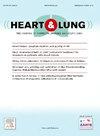长期COVID患者肺和内皮功能的关系:急性感染后两年
IF 2.6
4区 医学
Q2 CARDIAC & CARDIOVASCULAR SYSTEMS
引用次数: 0
摘要
内皮细胞可能是由SARS-CoV-2引起的急性呼吸窘迫综合征(ARDS)的起始和传播的主要来源,导致严重的内皮损伤和广泛的血栓形成。目的探讨肺功能对长冠肺炎患者血管反应的影响。方法观察性横断面研究。只进行了一次访问,在此期间填写评估表格并应用covid -19后功能状态量表(PCFS)。此外,参与者还接受了肱动脉血流介导的血管舒张评估和肺功能评估。结果共纳入32例患者,其中女性19例(59%)。平均年龄55.8±8.6岁,平均体重88.96±21.66 kg。从急性期开始,参与者的平均时间为32.25个月。患者平均FEV 1 /FVC为81.15±14.7 (%),KCO为93.72±7.95(%)。FMD平均为-0.21±11.24(%),表明内皮功能仍然受损。我们发现基底直径(-0.21[-4.26至3.84])与肺功能变量相关,尤其是KCO(%)变量(p <;0.001;R = 0.560)。当我们进行简单线性回归时,KCO(%)表明,仅这一变量就影响了29%的对参与者基底直径的响应。结论COVID-19感染患者恢复2年后内皮功能发生改变,这对个体心血管健康具有重要意义。本文章由计算机程序翻译,如有差异,请以英文原文为准。
Associations between lung and endothelial function in long COVID: Two years after acute infection
Background
endothelial cells may be a primary source for the initiation and spread of Acute Respiratory Distress Syndrome (ARDS) caused by SARS-CoV-2, resulting in severe endothelial injury and widespread thrombosis.
Objective
The objective of this study was to evaluate the influence of lung function on the vascular response of patients with long COVID.
Methods
This is an observational and cross-sectional study. Only one visit was performed, during which the evaluation form was completed and the post-COVID-19 Functional Status Scale (PCFS) was applied. In addition, participants underwent the assessment of flow-mediated vasodilation in the brachial artery and the assessment of pulmonary function.
Results
A total of 32 participants were included, of which 19 (59 %) were women. The mean age was 55.8 ± 8.6 years, with a mean weight of 88.96 ± 21.66 kg. The participants had an average time of 32.25 months since the acute phase. The patients had an average of FEV₁/FVC 81.15±14.7 ( %) and KCO 93.72±7.95 ( %). FMD had an average of -0.21±11.24 ( %), indicating still impaired endothelial function. We found correlation between basal diameter (-0.21 [-4.26 to 3.84]) vs lung function variables, especially with the variable KCO ( %) (p < 0.001; r = 0.560). When we perform simple linear regression KCO ( %) indicates that this variable alone influences 29 % of the response to the basal diameter of the participants.
Conclusion
Two years after recovery from COVID-19 infection, the patients present changes in endothelial function, which have important implications for individuals when it comes to cardiovascular health.
求助全文
通过发布文献求助,成功后即可免费获取论文全文。
去求助
来源期刊

Heart & Lung
医学-呼吸系统
CiteScore
4.60
自引率
3.60%
发文量
184
审稿时长
35 days
期刊介绍:
Heart & Lung: The Journal of Cardiopulmonary and Acute Care, the official publication of The American Association of Heart Failure Nurses, presents original, peer-reviewed articles on techniques, advances, investigations, and observations related to the care of patients with acute and critical illness and patients with chronic cardiac or pulmonary disorders.
The Journal''s acute care articles focus on the care of hospitalized patients, including those in the critical and acute care settings. Because most patients who are hospitalized in acute and critical care settings have chronic conditions, we are also interested in the chronically critically ill, the care of patients with chronic cardiopulmonary disorders, their rehabilitation, and disease prevention. The Journal''s heart failure articles focus on all aspects of the care of patients with this condition. Manuscripts that are relevant to populations across the human lifespan are welcome.
 求助内容:
求助内容: 应助结果提醒方式:
应助结果提醒方式:


